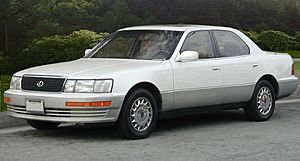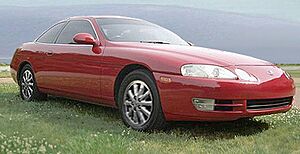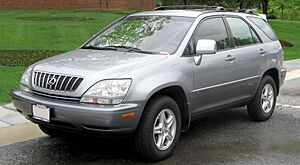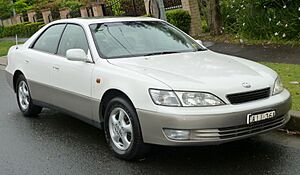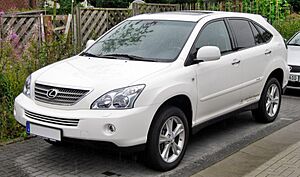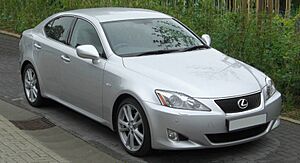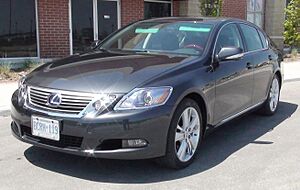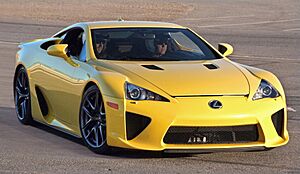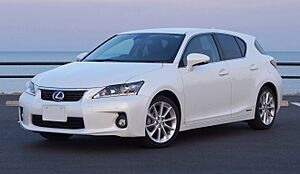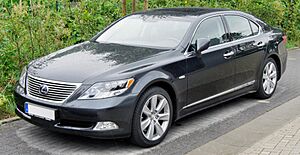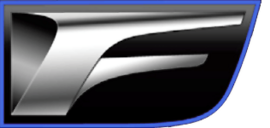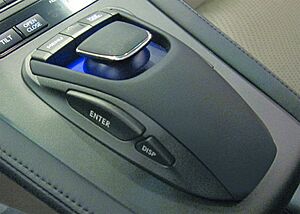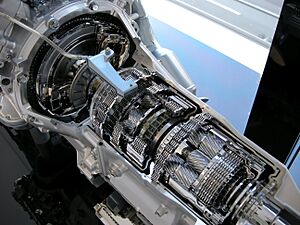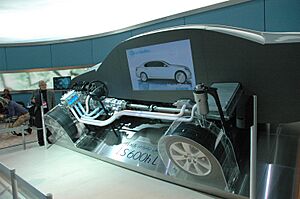Lexus facts for kids
 |
|
| Division | |
| Industry | Automotive |
| Founded | 1989 |
| Founder | Eiji Toyoda |
| Headquarters | Shimoyama, Aichi, Japan |
|
Area served
|
Worldwide |
|
Key people
|
|
| Products |
|
| Brands | F marque |
| Services | Automotive financing |
| Parent | Toyota Motor Corporation |
Lexus (レクサス, Rekusasu) is the fancy car brand of the Japanese car company Toyota Motor Corporation. Lexus cars are sold in over 90 countries around the world. It is Japan's top-selling brand of high-end cars. Lexus has been one of the top 10 most valuable Japanese brands globally. Since 2024, Lexus has been based in Shimoyama, Aichi, Japan. It also has offices in Brussels, Belgium, and Plano, Texas, United States.
Lexus started around the same time other Japanese car makers like Honda (with Acura) and Nissan (with Infiniti) created their own luxury brands. Lexus began as a special project in 1983 to build a new, high-quality sedan. This project led to the launch of the Lexus LS in 1989. After that, Lexus added different types of cars like sedans, coupés, convertibles, and SUVs.
Before 2005, Lexus cars were not sold under the Lexus name in Japan. They were sold as Toyota models. In 2005, Lexus introduced its first hybrid car, the RX crossover. More hybrid models were added later. In 2007, Lexus launched its special performance division called F marque with the IS F sport sedan. The LFA supercar followed in 2009.
Most Lexus cars are made in Japan, mainly in the Chūbu and Kyūshū areas. Toyota's Tahara and Miyata plants are key production sites. The first Lexus made outside Japan was the RX 330, built in Canada starting in 2003. From 2001 to 2005, Lexus changed its structure to have its own teams for design, engineering, and manufacturing.
Since the 2000s, Lexus has sold more cars outside its biggest market, the United States. In 2005, Lexus opened its own dealerships in Japan. This made it the first Japanese luxury car brand to launch in its home country. The brand has also started selling cars in Southeast Asia, Latin America, Europe, and other places. It has also brought hybrid cars to many markets.
How Lexus Started
The F1 Project: Building a Top Car
The Lexus brand was created when Japanese car companies like Nissan and Honda also started their own luxury brands, Infiniti and Acura. The Japanese government had rules that limited how many cars could be sent to the U.S. market. This made it more profitable for Japanese car makers to send more expensive cars to the U.S.
In 1983, Toyota's chairman, Eiji Toyoda, gave a challenge: build the best car in the world. This project was called F1, which stood for "Flagship One." The goal was to create the Lexus LS 400. This car would help Toyota sell cars in the luxury market. The F1 project came after Toyota's Toyota Supra sports car and the fancy Toyota Mark II models.
Toyota's designers wanted their new luxury car for international markets. They started working on a new V8 engine for it.
Japanese car makers sent more expensive cars abroad in the 1980s because of trade agreements with the U.S. In 1986, Honda launched its Acura brand in the U.S. This influenced Toyota's plans for a luxury division. In 1987, Nissan also announced plans for its luxury brand, Infiniti.
Toyota researchers visited the U.S. in 1985. They talked to luxury car buyers to understand their likes and dislikes. Some F1 designers even rented a house in Laguna Beach, California, to see how wealthy Americans lived. Meanwhile, F1 engineers tested car prototypes on roads from German autobahns to U.S. highways. Toyota realized they needed a separate brand and sales network for their new luxury car. They planned to open new dealerships in the U.S.
Creating the Lexus Name
In 1986, Toyota's advertising agency, Saatchi & Saatchi, created a special team called Team One to market the new brand. A company called Lippincott & Margulies helped come up with 219 possible names. Some top choices were Vectre, Verone, Chaparel, Calibre, and Alexis. Alexis was a favorite, but people worried it sounded too much like a person's name, especially a character from the TV show Dynasty. So, the first letter was removed, and the "i" was changed to a "u," making it Lexus.
Some people thought Lexus meant "luxury" and "elegance" combined, or "luxury exports to the U.S." But according to Team One, the name doesn't have a specific meaning. It was chosen to sound luxurious and advanced. Before the cars were released, a company called LexisNexis tried to stop Lexus from using the name, saying it might cause confusion. However, a U.S. court allowed Lexus to use the name, saying there was little chance of confusion.
The first Lexus slogan was "The Relentless Pursuit of Perfection." This slogan came from seeing how much attention to detail Lexus designers had. Three companies helped create the Lexus logo. The "L" shape came from Hunter/Korobkin, Inc., and the Lexus wordmark came from Saatchi & Saatchi. Toyota made some small changes to the logo to make it easier to produce. The first ads showing the Lexus name and logo appeared at car shows in 1988.
The Big Launch
The F1 project finished in 1989. It involved 60 designers, 24 engineering teams, 1,400 engineers, 2,300 technicians, and 220 support staff. They built about 450 test cars and spent over $1 billion. The car they created was the Lexus LS 400. It had a completely new design, a new 4.0 L V8 gasoline engine, and rear-wheel drive.
The LS 400 was shown in January 1989 at the North American International Auto Show in Detroit. Sales officially started in September 1989 at 81 new Lexus dealerships in the U.S. The LS 400 was sold alongside the smaller ES 250. The ES 250 was a rebadged version of the Toyota Camry Prominent/Toyota Vista sold in Japan. A big advertising campaign launched Lexus.
People praised the LS 400 for being quiet, having a comfortable and well-designed interior, good engine power, high quality, good aerodynamics, great fuel economy, and good value. Some car writers thought its style was too plain. It was also criticized for a suspension that was too soft for sporty driving. In some markets, it was priced against mid-size Mercedes-Benz and BMW cars. Car and Driver magazine said it was better than the more expensive Mercedes-Benz 420 SEL and BMW 735i in terms of ride, handling, and performance. The LS 400 also won many awards from car magazines.
Lexus quickly gained loyal customers. Its launch surprised other luxury car brands. BMW's and Mercedes-Benz's sales in the U.S. dropped after Lexus arrived. Many Lexus buyers traded in their Lincoln or Cadillac cars.
In December 1989, Lexus voluntarily recalled all 8,000 LS 400s. This was because of two customer complaints about faulty wiring and an overheated brake light. Lexus quickly fixed the issue. They even sent technicians to pick up, repair, and return cars to customers for free. They also flew staff and rented garages for owners in far-off places. This quick response was reported in the news and helped Lexus build a strong reputation for great customer service.
By the end of 1989, Lexus sold 16,392 LS 400 and ES 250 sedans in the U.S. in just four months. This met their goal for that year. After these first models, Lexus planned to add a sports coupe and a redesigned ES sedan.
Growing and Expanding in the 1990s
In 1990, its first full year of sales, Lexus sold 63,594 LS 400 and ES 250 sedans in the U.S. Most of these were the LS model. That year, Lexus also started selling cars in the United Kingdom, Switzerland, Canada, and Australia. In 1991, Lexus launched its first sports coupe, the SC 400. It used the same V8 engine and rear-wheel drive as the LS 400. Then came the second-generation ES 300 sedan, which replaced the ES 250 and became Lexus' best-selling car. By the end of 1991, Lexus was the top-selling imported luxury car in the U.S., with 71,206 vehicles sold.
That year, Lexus ranked highest in J.D. Power and Associates' surveys for car quality, customer happiness, and sales experience. Lexus also started raising its prices in the U.S. to be higher than American luxury brands, but still lower than high-end European models. By 1992, the LS 400's starting price had gone up by 18 percent.
In 1993, Lexus launched the mid-size GS 300 sports sedan. It was based on the Toyota Aristo, which had been sold in Japan for two years. The GS 300 was priced lower than the LS 400. That same year, Lexus was one of the first brands to offer a program for certified pre-owned cars. This helped improve the value of trade-in cars. Lexus introduced the second-generation LS 400 in 1994.
In 1996, Lexus introduced its first sport utility vehicle, the LX 450. This was followed by the third-generation ES 300 sedan, and the second-generation GS 300 and GS 400 sedans in 1997. Lexus then added the first luxury crossover SUV, the RX 300, in 1998. The RX crossover was made for people who wanted a fancy SUV but didn't need the LX's off-road abilities. It became very popular and was eventually Lexus' best-selling model, even more than the ES sedan. In 1999, the IS was introduced as a smaller, sportier sedan. Lexus also sold its 1 millionth car in the U.S. market and became the top-selling luxury car maker in the U.S. overall.
Global Changes in the 2000s
In July 2000, Lexus launched the IS 300 in North America, and the third-generation LS 430. In 2001, the first convertible, the SC 430, was introduced, along with a redesigned ES 300. The GX 470 mid-size SUV came out in 2002, followed by the second-generation RX 330 in 2003. The next year, Lexus sold its 2 millionth car in the U.S. They also launched the first luxury hybrid SUV, the RX 400h. This car used Toyota's Hybrid Synergy Drive system, which combines gasoline and electric motors.
In 2005, Lexus became more independent from its parent company, Toyota. It now had its own teams for design, engineering, training, and manufacturing. This change happened as Lexus launched in its home market of Japan and expanded globally to places like China. Lexus wanted to sell more cars outside the U.S. To help with this, new Lexus cars were designed as "global models" for release around the world. In Europe, where Lexus had struggled with sales, the brand planned to offer hybrid and diesel engines, open more dealerships, and grow in new markets like Russia.
Lexus' arrival in Japan in July 2005 was the first time a Japanese luxury car brand launched in its own country. New LS, IS, ES, GS, and RX models became available in Japan. This meant that Toyota-branded models like the Celsior and Harrier were no longer sold there. Lexus models sold in Japan had more features and were more expensive than the Toyota models they replaced. Sales were slower than expected at first but improved later.
In the mid-2000s, Lexus had great success in South Korea and Taiwan, becoming the top-selling imported brand in both markets in 2005. It also sold well in the Middle East and Australia. By 2006, Lexus aimed to expand from 68 countries to 76 by 2010. This led to launches in Malaysia and South Africa in 2006, Indonesia in 2007, Chile in 2008, and the Philippines in 2009.
Hybrids and F Models
In 2006, Lexus started selling the GS 450h, a V6 hybrid performance sedan. It also launched the fourth-generation LS line, which included V8 (LS 460 and LS 460 L) and hybrid (LS 600h and LS 600h L) versions. The fifth-generation ES 350 also came out that year. The LS 600h L became the most expensive sedan ever made in Japan. By the end of 2006, Lexus had sold 475,000 cars worldwide. In January 2007, Lexus announced its new F marque performance division. This division would make racing-inspired versions of its cars. The IS F debuted at the 2007 North American International Auto Show, along with a concept car called the LF-A.
In October 2007, Lexus showed the IS F at the Specialty Equipment Market Association show in the U.S. for the first time. It also announced its F-Sport performance parts and accessories. Lexus wanted to make sportier cars to compete with brands like Mercedes-Benz's AMG and BMW's M divisions. While some Lexus models were sporty, most were known for comfort rather than super-sporty handling. By the end of 2007, Lexus had sold over 500,000 cars worldwide. It was also the top-selling imported luxury car in China for the first time.
In 2008, during a worldwide economic slowdown, global sales dropped by 16 percent to 435,000 cars. In 2009, Lexus launched the HS 250h, a hybrid sedan for North America and Japan. It also released the RX 450h, the second-generation hybrid SUV. Later that year, the very expensive LFA exotic coupe debuted. By the end of the decade, Lexus was the fourth-largest luxury car brand in the world by sales volume. It was also the number one selling luxury car brand in the U.S. for 10 years in a row.
Recent Developments (2010s–2020s)
In 2010, Lexus sales slowly started to recover in North America and Asia. The brand focused on adding more hybrid cars and new versions of existing models. Sales in the U.S. stayed steady even with the 2009–2010 Toyota vehicle recalls, which included some Lexus models. The ES 350 and some IS models were recalled for floor mat issues. Toyota, the parent company, faced most of the negative news about its recalls.
In late 2010 and early 2011, Lexus began selling the CT 200h, a small four-door hybrid hatchback designed for Europe. Sales of smaller regional models also grew, like the ES 240 in China and the RX 270. In March 2011, the Tōhoku earthquake and tsunami in Japan severely affected Lexus' production lines. This hurt the brand's sales in the short term.
By the end of 2011, Lexus sales in the U.S. dropped by 14 percent. However, sales increased by 40 percent in Europe and 27 percent in Japan. Total global sales were 410,000 units. Lexus' 11-year streak as the best-selling luxury brand in the U.S. ended that year, with BMW taking the top spot. Toyota chairman Akio Toyoda promised to make Lexus more exciting and independent. He said that before, Lexus was seen more as a sales channel than a brand. Because of Toyoda's changes, Lexus managers now report directly to the chairman.
In January 2012, Lexus started selling the fourth-generation GS line, including GS 350 and GS 450h models. A smaller GS 250 model was also available in some markets. In April 2012, the sixth-generation ES line, including ES 350 and ES 300h models, debuted at the New York International Auto Show.
In April 2014, Lexus showed off the five-seater NX crossover. This car was the first Lexus vehicle to have a turbocharger. In August 2014, Toyota announced it would lower Lexus spare parts prices in China by up to 35 percent. This was in response to an investigation by China's government into high prices for car parts and service.
In March 2016, Lexus announced a new top-of-the-line car: the two-door LC 500. This car would be produced in late 2017 with a V8 engine. A V6 hybrid version, the LC 500h, was also planned.
In April 2019, Lexus announced that a luxury version of the Toyota Alphard minivan would be sold as the Lexus LM. It was also announced that Lexus would finally enter the market in Mexico in 2021. In October 2019, Lexus said it would launch its first all-battery electric vehicle in 2020, the UX 300e. In June 2023, Lexus introduced its first small car, the LBX, which went on sale in Europe, Japan, Australia, and Southeast Asia.
How Lexus Works
| Regional sales, 2011 | Units |
|---|---|
| Japan | 42,365 |
| China | 56,303 |
| Europe | 43,637 |
| United States | 198,552 |
| Type production, 2010 | Units |
| Passenger vehicles | 205,070 |
| Crossover SUVs | 159,560 |
| Hybrid vehicles | 66,226 |
| Line production, 2010 | Units |
| Japan production | 283,012 |
| Canada production | 81,618 |
| Total | 364,630 |
Lexus International manages Lexus' global operations from its main office in Nagoya, Aichi, Japan. It handles sales, marketing, and product planning worldwide. Even though it's separate from Toyota, Lexus International reports directly to Toyota's CEO, Akio Toyoda. In the U.S., Lexus operations are managed from Plano, Texas. In Europe, Lexus Europe manages operations from Brussels. Lexus also has design centers in Southern California and Japan.
Lexus sales work differently in various regions. In many places, like the U.S., dealerships are separate businesses from Lexus headquarters. They own and run their own Lexus showrooms. But in Japan, Lexus owns and runs all 143 dealerships. Some markets have a special third-party company that distributes Lexus cars.
Lexus launched in India in 2017 with models like the RX450h and LX450d. Dealerships opened in major cities in March 2017. This made Lexus the fifth luxury brand to launch in India.
Sales Performance
Lexus sold a record 518,000 cars globally in 2007. Sales dropped in the following years due to the 2008 economic downturn and the 2011 Japanese tsunami. After that, sales recovered and reached a new high of 523,000 in 2013.
In 2014, Lexus set another global sales record, selling 582,000 vehicles. This made Lexus the fourth best-selling luxury brand in the world, after BMW, Audi, and Mercedes-Benz.
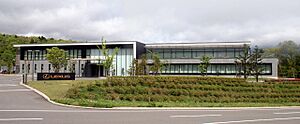
Global sales of Lexus cars increased by 12 percent in 2015, reaching another record of 652,000 units sold worldwide.
Lexus sold its 500,000th hybrid electric car globally in November 2012. The 1 million sales milestone for hybrids was reached in March 2016. The Lexus RX 400h/RX 450h is the best-selling Lexus hybrid, with 335,000 units sold globally as of March 2016. The Lexus CT 200h is second with 267,000 units.
Lexus has not sold as well in Europe as it has in other parts of the world. This is thought to be because it's not as well-known there, and it has fewer dealerships. In Europe, the Lexus LS sells less than BMW, Mercedes-Benz, Audi, and Jaguar luxury cars. Car experts suggest that European buyers might care less about car reliability and be more loyal to their own country's car brands. However, outside Europe, like in South Africa, the Lexus LS sells very well, often second only to the Mercedes-Benz S-Class.
Currently, all Lexus models for the U.S. market are imported from Japan. The only exceptions are the RX and NX, which are also made in Cambridge, Ontario, Canada, for North America. The ES is also made in Georgetown, Kentucky. The RX mid-size crossover is Lexus' best-selling model in the United States. The ES mid-size car is the most popular sedan.
| Calendar Year | Europe | US (Market share %) |
|---|---|---|
| 2023 | - | |
| 2022 | 38,366 | |
| 2021 | 46,250 | |
| 2020 | 47,041 | |
| 2019 | 55,770 | |
| 2018 | 45,918 | |
| 2017 | 44,944 | |
| 2016 | 44,287 | |
| 2015 | 39,255 | |
| 2014 | 31,479 | |
| 2013 | 23,708 | |
| 2012 | 26,820 | |
| 2011 | 27,442 | |
| 2010 | 19,185 | |
| 2009 | 20,629 | |
| 2008 | 29,682 | |
| 2007 | 40,496 | |
| 2006 | 40,337 | |
| 2005 | 23,340 | |
| 2004 | 21,122 | |
| 2003 | 18,318 | |
| 2002 | 19,435 | |
| 2001 | 21,357 | |
| 2000 | 17,214 | |
| 1999 | 15,800 | |
| 1998 | 6,938 | |
| 1997 | 3,408 | |
| 1996 | ||
| 1995 | ||
| 1994 | ||
| 1993 | ||
| 1992 | ||
| 1991 | ||
| 1990 | ||
| 1989 | ||
| 1988 | 0 (0.00) |
Financial Success
Lexus' financial details are not made public. However, car experts believe that Lexus brings in a large share of Toyota's profits, even though it produces and sells fewer cars. In some years, Lexus sales have made up half of Toyota's annual U.S. profit. Lexus has focused on keeping its profit margins high, offering fewer sales incentives than other luxury brands. In 2006, Lexus was listed among the Top 100 Global Brands for the first time. In 2009, it was ranked as Japan's seventh-largest brand.
Lexus Cars
Car Models
The Lexus car lineup includes different sizes of sedans: the small IS, mid-size ES, and large LS. The 2-door coupe range has the RC and the LC. Lexus used to make convertibles like the SC and IS C.
Lexus also makes SUVs and crossovers. These range from the small UX, compact NX, and mid-size RX crossovers, to the large GX and LX. The F marque line makes high-performance versions of the RC coupe. It used to make special versions of the IS and GS, and the LFA supercar.
F Marque: High Performance Cars
Lexus creates its most powerful cars under its F marque division. The "F" stands for Flagship and Fuji Speedway in Japan. The first turn of the Fuji Speedway, called 27R, inspired the shape of the "F" logo. F marque cars are developed by the Lexus Vehicle Performance Development Division. The first F marque model, the IS F, went on sale in 2007. The LFA followed in 2009.
There's also an F-Sport trim level and special accessories for regular Lexus models like the IS 250 and IS 350. F-Sport usually adds sporty looks to the outside and inside of the car. In some cars, it also includes mechanical upgrades like a special adjustable suspension.
How Lexus Names Its Models
Lexus car models are named using two letters followed by three numbers. The first letter shows how important the car is in the Lexus range. The second letter tells you the car's body style or type (for example, LS means 'luxury sedan'). The three numbers usually show the engine displacement in liters multiplied by one hundred (e.g., 350 for a 3.5 L engine). For turbocharged and hybrid cars, the numbers show the power of a regular engine that would have similar output.
A space is used between the letters and numbers. The same letter can mean different things depending on the model. For example, 'S' can mean 'sedan' or 'sport' (like in LS and SC). 'X' means 'luxury utility vehicle' or SUV. For some models, a small letter after the name shows the engine type ('h' for hybrid, 'd' for diesel, 't' for turbocharged). Capital letters at the end show a special type of car (like 'L' for long-wheelbase, 'C' for coupe, 'AWD' for all-wheel drive). On F marque models, only the two-letter name and the letter 'F' are used, with no numbers or hyphens (e.g., IS F).
Design and Technology
Lexus car design has always focused on meeting specific standards. From the beginning, design goals included good aerodynamics and a smooth ride quality, as well as comfortable interiors. The word "IDEAL" ("Impressive, Dynamic, Elegant, Advanced, and Lasting") is used in the design process. Each car is designed to meet about 500 specific product standards, called "Lexus Musts." These include details like the stitching on leather seats. Design ideas from Lexus' concept cars, the LF series, have been used in the cars they sell.
Lexus car interiors have special features like bright electroluminescent Optitron gauges and SmartAccess, a smart key system for entry and starting the car. They also have multimedia features. Starting with the 2010 RX and HS models, the Remote Touch system was introduced. This system uses a computer mouse-like controller with haptic feedback. Other models used touchscreen controls for navigation. In 2014, Lexus introduced the Remote Touch Interface Touchpad in the new RC Coupe.
In 1989, Lexus was one of the first luxury car brands to offer high-quality audio systems, working with the company Nakamichi. Since 2001, optional surround sound systems have been offered through Mark Levinson. To make the car cabins quieter, the first LS 400 used special steel plating. Later models added acoustic glass. In 2006, the LS 460 was the first car to have ceiling air diffusers and infrared body temperature sensors. Lexus also offers Telematics services like G-Link in Asia and Lexus Enform in North America.
In 2006, Lexus put the first production eight-speed automatic transmission in a car, the LS 460. This gearbox was later used in the GS 460 and IS F models. All Lexus hybrid models use Continuously variable transmissions, regenerative brakes, and electric motors. In 2007, Lexus said it planned to put hybrid engines in more models. This was to meet the demand for cars that produce less carbon pollution and use less oil. Hybrid models have special badges and lighting. In 2008, the LS 600h L was the first production car to use LED headlamps.
Lexus cars have many safety features. These include systems for stability and handling (Vehicle Stability Control and Vehicle Dynamics Integrated Management), backup cameras, headlights that turn with the car, and sonar warning systems. The Lexus Pre-Collision System (PCS) combines several safety systems. In 2007, Lexus introduced the first car safety systems with infrared and pedestrian detection. It also had lane keep assist, a Driver Monitoring System that uses facial recognition to check if the driver is paying attention, and rear pre-collision whiplash protection.
Lexus has been developing new models like convertibles, crossovers, and special hybrids. Under the F marque, Lexus plans to make high-performance cars like the IS F and LFA. Lexus also tests its cars at the Nürburgring race track in Germany.
L-finesse Design
Lexus introduced a new design language called "L-finesse" in the mid-2000s. This design was first seen in its LF series concept cars and the 2006 Lexus GS. L-finesse is based on three Japanese words that mean "Intriguing Elegance, Incisive Simplicity, and Seamless Anticipation." Design features like a fastback shape, a lower grille, and the use of curved and hollow surfaces come from Japanese culture. While older Lexus models were sometimes seen as plain, L-finesse made Lexus cars look more unique and showed off Japanese design.
Car Production
Where Lexus Cars Are Made
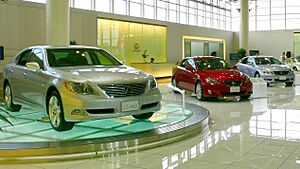
The first Lexus cars were made at Toyota's Tahara plant in Japan, which is a very advanced factory. Through the 2000s, most Lexus sedans and SUVs were made in Japan at the Tahara plant in Aichi and the Miyata plant in Fukuoka. Lexus cars have also been made at other Toyota plants in Japan. Front-wheel drive cars, like the ES and HS, have been made in the Fukuoka Prefecture.
Toyota Motor Kyushu's Kokura plant in Kitakyushu, Fukuoka, which opened in 2008, is a special factory for hybrid systems used in Lexus models like the RX hybrid. The RX 350 for North America has been made at the Cambridge plant in Cambridge, Canada, since 2004. This was the first Lexus production site outside Japan. In late 2015, Lexus started making North American-spec ES 350 sedans at the Georgetown plant in Kentucky. In January 2020, Toyota Kirloskar Motor in India started assembling the ES sedan. Toyota also plans to make Lexus electric vehicles in its Shanghai factory starting in 2027.
Lexus cars are built with higher quality control standards than regular Toyota models. This includes very precise fitting of body panels and high paint quality. They use different assembly lines, molds, and equipment. Lexus factory workers also go through a very careful selection process. Finished cars are visually checked for flaws, test-driven at high speeds, and put through vibration tests.
| Plant | Owner | Location | Country | Model(s) |
|---|---|---|---|---|
| Tahara | Toyota Motor Corp. | Tahara, Aichi Prefecture | Japan | LS, GS, IS, GX, RC, NX, LM |
| Tsutsumi | Toyota Motor Corp. | Toyota City, Aichi Prefecture | ES | |
| Kokura | Toyota Motor Kyushu, Inc. | Kitakyushu, Fukuoka Prefecture | CT, HS, RX | |
| Miyata | Toyota Motor Kyushu, Inc. | Miyawaka, Fukuoka Prefecture | ES, IS, RX, NX, UX | |
| Motomachi | Toyota Motor Corp. | Toyota City, Aichi Prefecture | LFA, LC, RZ | |
| Higashi Fuji | Kanto Auto Works, Ltd. | Susono, Shizuoka Prefecture | SC | |
| Yoshiwara | Toyota Auto Body Corp. | Toyota City, Aichi Prefecture | LX | |
| Cambridge | Toyota Motor Manufacturing Canada | Cambridge, Ontario | Canada | RX, RXh, NX |
| Georgetown | Toyota Motor Manufacturing Kentucky | Georgetown, Kentucky | United States | ES |
| Princeton | Toyota Motor Manufacturing Indiana | Princeton, Indiana | TX | |
| Bidadi | Toyota Kirloskar Motor | Bidadi, Karnataka | India | ES |
| Shanghai | Toyota Motor Corp. | Jinshan, Shanghai | China | Future EVs |
Quality Rankings
In the 2000s, Consumer Reports magazine often named Lexus among the top five most reliable car brands in its surveys. These surveys included over a million vehicles across the U.S.
Customer Service
Lexus is known for providing excellent customer service, especially after a car is sold. Waiting areas at service centers often have nice amenities like refreshment bars. Dealerships usually offer free loaner cars and free car washes. Some even have cafes and fancy shops. Service bays often have large windows so owners can watch their car being worked on. In 2005, Lexus started reserving parking lots at major sports events and shopping malls. The only requirement for free entry was owning a Lexus car. Lexus Magazine, an online publication for owners, features articles about cars and lifestyle.
Since 2002, Lexus has received top ratings in customer satisfaction surveys in the UK. Lexus has also topped surveys by the Luxury Institute in New York. To improve customer service, employees are taught to follow the "Lexus Covenant." This is the brand's founding promise: "Lexus will treat each customer as we would a guest in our home." Some dealerships even train their staff at high-end stores like Nordstrom and Ritz-Carlton hotels.
Motorsport
Lexus first entered car racing in 1999. Its racing team, Team Lexus, raced two GS 400 cars in a touring car series. In its first season, Team Lexus won its sixth race. In 2001, Team Lexus started racing three IS 300s. They won their first IS 300 race that year. In 2002, Team Lexus won the Drivers' and Team Championships in their racing class.
After Lexus launched in Japan in 2005, Lexus supported four SC 430 coupes entering the Super GT series. In the first race of the 2006 series, an SC 430 won. Drivers André Lotterer and Juichi Wakisaka then won the GT500 championship that year with the SC 430. In 2006, Lexus raced a hybrid car for the first time, a GS 450h performance hybrid sedan.
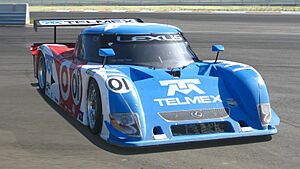
Lexus has also raced in endurance races like the Rolex 24 Hours of Daytona. After joining the Rolex Sports Car Series in 2004, Lexus has won over 15 races. In 2006, Lexus won the championship. In 2007, a Lexus-powered car won the Rolex 24 Hours of Daytona race again. Lexus won its third straight win at Daytona in 2008.
The LF-A prototype also raced at the Nürburgring from 2008 to 2011. In 2011, a CT 200h tuned by Gazoo Racing competed in a six-hour endurance race.
3GT Racing, working with Lexus, entered two Lexus RC F GT3 cars in the North American 2017 WeatherTech SportsCar Championship in the GT Daytona class. They got their first win in 2018. For the 2019 WeatherTech SportsCar Championship, the Lexus GT3 cars were run by AIM Vasser Sullivan. They achieved two wins that season.
Marketing and Advertising
From the start, Lexus has used special marketing strategies to advertise to luxury buyers. Their ads have a consistent style. From 1989 to 2009, actor James Sloyan narrated the TV ads. The ads often showed cars doing amazing stunts. Early commercials focused on words like "relentless," "pursuit," and "perfection." They showed how precise, quiet, and comfortable Lexus cars were. Famous examples include the "Balance" ad (1989) with champagne glasses and the "Ball Bearing" ad (1992).
In the 2000s, commercials described car features and often compared Lexus to German luxury brands. An annual "December to Remember" campaign showed families surprising loved ones with a new Lexus. Lexus brought back the champagne glass theme in a 2006 ad for the LS 460. It showed the sedan moving between two stacks of glasses using its self-parking system. A 2010 LFA ad showed its engine sound shattering a glass.
Experts say Lexus' early marketing success came from its high quality and lower prices compared to competitors. This helped it attract customers who were upgrading from regular cars. Its reputation for reliability also brought in new customers from rival luxury brands. Lexus now sells its new models at higher prices, with some costing over $100,000.
Some car experts have noted that Lexus is a newer brand compared to its European rivals, which have decades of history. European brands often highlight their long heritage. Lexus' reputation is mostly based on its quality and its connection to Toyota. Experts say Lexus will need to build its own history by showing off new technologies and making great products.
Lexus also sponsors sports and charity events. These include the U.S. Open tennis tournament and the United States Golf Association's golf tournaments. Lexus has held an annual Champions for Charity golf series in the U.S. since 1989. They have also signed deals with famous athletes like Hideki Matsuyama and Andy Roddick.
Since 2008, Lexus has run a video website called L Studio. Shows on L Studio include Web Therapy.
Lexus launched its new "Experience Amazing" slogan in the U.S. with an ad during the February 2017 Super Bowl LI. This new slogan replaced "Amazing in Motion" and "The Pursuit of Perfection."
On March 30, 2018, Lexus showed a fake partnership with 23 and Me during a spot on Saturday Night Live. It was an April Fool's Day joke about customizing cars based on DNA.
Lexus renewed its sponsorship of the Esports Awards on October 23, 2024. As part of this, Lexus will present awards for "Esports Content Creator of the Year" and "Esports Organization of Year" in November 2024.
Lexus Slogans
- The Relentless Pursuit of Perfection (1989–2011)
- The Pursuit of Perfection (2010–2016)
- Amazing in Motion (2013–2016)
- Experience Amazing (2017–present)
See also
 In Spanish: Lexus para niños
In Spanish: Lexus para niños
- The Championship by Lexus
- Slide (hoverboard)


